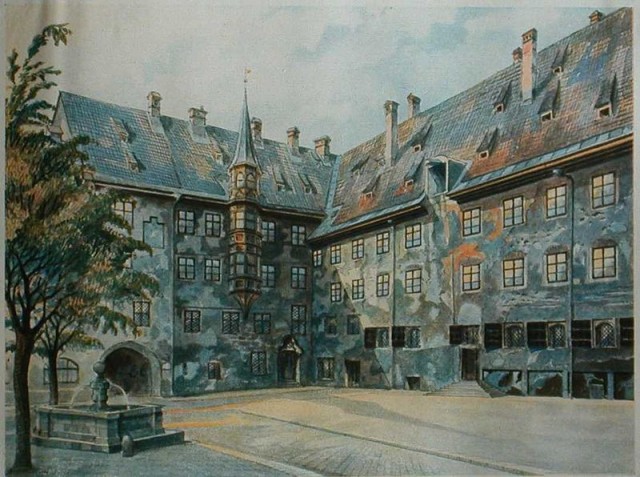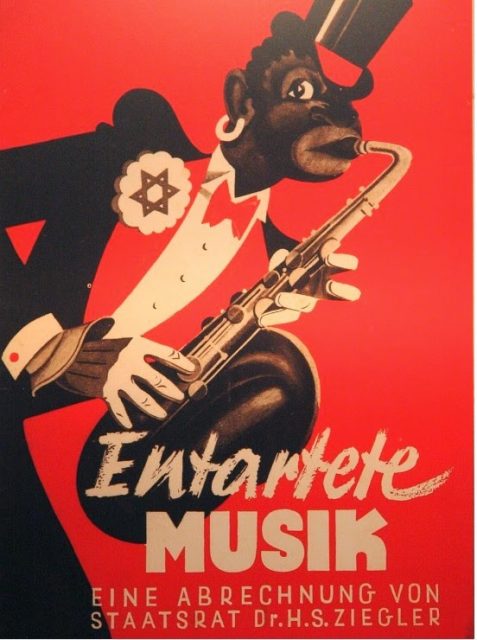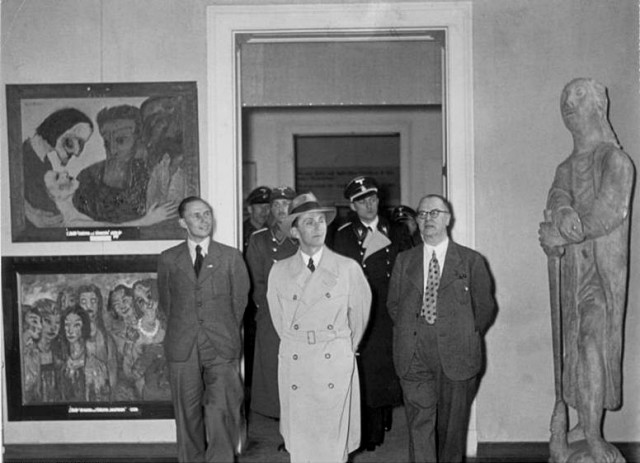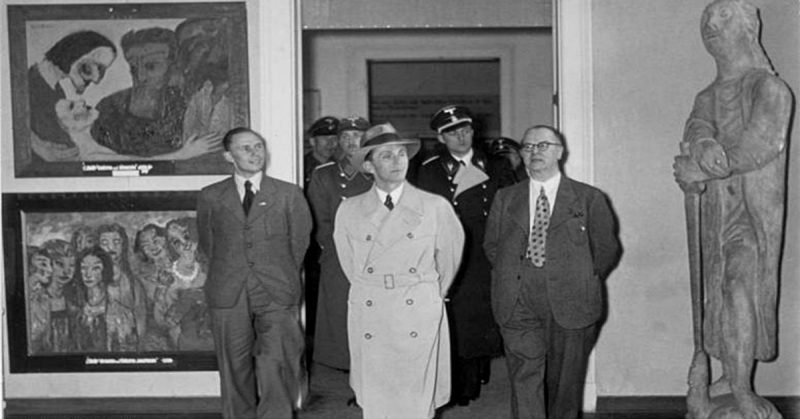Hitler’s views on art were problematic, to say the least. In 1906, he moved from Steyr, where he attended high school, to Vienna, which was one of the cultural centres of Europe at the time. Mind you, art was changing rapidly at the beginning of the 20th century and the style of modernism was appearing in books, paintings, music, sculptures, and buildings alike. Hitler painted watercolors of Vienna’s popular sights and nurtured a rather old-fashioned approach, partly because of his conservative ideology.
He was opposed to the new tendencies in art, as he thought they were vulgar and insulting. He wasn’t the only one to think so since many saw modernist art as cryptic, hermetic and elitist, for it tried hard to break with the traditional conventions.
Hitler wanted to be the next great artist of the “Classical tradition” following the works of 19th-century Realist painters, the Italian Rennaissance, and Neo-Classicism, which relied on the Graco-Roman tradition. He also admired architecture from an early age, drawing buildings by remembering them and adding elements that would, in his opinion, make them more astonishing. Adolf Hitler had his work rejected twice by the Academy of Fine Arts in Vienna, in 1907 and the following year.
His mother died soon afterwards, of breast cancer. These were the events that formed Hitler’s persona and to understand his initial success as the leader of Germany, we must understand his views on the aesthetic principles he found fit for the future Third Reich.
After he was elected the Chancellor of Germany, Hitler, and the Nazi Party already had strong views on how the German culture should look like and what it should represent. Meanwhile, Expressionism, a modernist movement, was blooming, most notably among German painters and film directors. It drew much of its dark iconography out of the horrible experience of the First World War and the depravity that hit Germany afterwards.

In 1933, the Nazis paved the road for the completely state-controlled culture, by organizing book burnings, dismissing artists and musicians from teaching positions and replacing curators who expressed sympathies towards modern art with party officials. Furthermore, Reich Culture Chamber was established, under the leadership of Joseph Goebbels, Hitler’s Minister of Public Enlightenment and Propaganda.
They demanded racial purity among the artists and their compliance with the Nazi Party. Hitler insisted that modernists’ imagery is pornographic, insulting, pathologically sick, backed by Communists and Zionists and summed up all into one word ― “degenerate”. In 1937, he created the pinnacle of his war on modernism― a large exhibition of modernist art in the purpose of slandering it in public.
The event was titled The Degenerate Art exhibition and it showed works of the “degenerate” artists piled without order, usually followed by an inappropriate commentary which ridiculed them. Some of the commentaries were (in context with the selected painting): “Revelation of the Jewish racial soul”, “The ideal—cretin and whore”, “Deliberate sabotage of national defense”, “Madness becomes method”, “Nature as seen by sick minds”…

However, Goebbels supported some expressionist artists, most notable among them, Emil Nolde (who was a devoted Nazi Party member), as he claimed that the Nazis were prophets of the “new modernity”. It was Alfred Rosenberg who confronted Goebbels and won Hitler’s support against all art that identified itself as modernist.
Rosenberg was the Commissar for Supervision of Intellectual and Ideological Education in the Nazi Party and a sworn anti-Semite, who developed his racial theories long before Hitler came to power. He was one of the main ideologists of the Third Reich.
The Nazis managed to make bans in the field of high culture, but their interference wasn’t that obvious in popular culture; Hollywood movies were screened regularly until the outbreak of the war and jazz, even though officially prohibited, was very popular in Germany in the 1930s with American bands performing in all major cities. The Nazis couldn’t keep a firm grip on the mass culture since they themselves feared it could provoke dissatisfaction with the government.
By 1937, the concept of degeneracy was firmly entrenched in Nazi policy. On June 30th of that year, Goebbels put Adolf Ziegler, the head of the Reich Chamber of Visual Art, in charge of a six-man commission authorized to confiscate from museums and art collections throughout the Reich, any remaining art deemed modern, degenerate, or subversive.
These works were then to be presented to the public in an exhibit intended to incite further revulsion against the “perverse Jewish spirit” penetrating German culture.

They had seized over 5,000 paintings of famous authors such as Marc Chagall, Pablo Picasso, Vincent Van Gogh, Ernst Ludwig Kirchner, Henri Matisse and others. The Degenerate Art Exhibition was opened on July 19th, 1937, in the building which was formerly used by the Institute of Archaeology.
It consisted more than 650 paintings, sculptures, prints, and books from the collections of 32 German museums. The exhibition remained on view until November 30th and featured in 11 other cities in Germany and Austria.
The exhibition used three thematically grouped rooms which were overfilled with paintings, often unframed. The first room represented the modernist take on religion stressing out the heretical dimension of the movement. The second room focused mainly on the Jewish artists.
The third dealt with the paintings that were deemed insulting to women, soldiers and farmers of Germany. The rest of the exhibit had no particular theme but was rather used to mock the artists representing them as chaotic and schizophrenic.
The manifestos of movements such as Dadaist or Surrealist were deliberately misinterpreted and followed by speeches of Nazi Party officials. Next to many paintings were labeled indicating how much money a museum spent to acquire the artwork.
In the case of paintings acquired during the post-war Weimar hyperinflation of the early 1920’s, when the cost of a kilo loaf of bread reached 233 billion German marks, the prices of the paintings were of course greatly exaggerated. The exhibit was designed to promote the idea that modernism was a conspiracy by people who hated German decency, frequently identified as Jewish-Bolshevist, although only six of the 112 artists included in the exhibition were, in fact, Jewish.
Besides from promoting their own cultural policy, the Nazis seized many works of art for profit. In their possession were 16,558 priceless original paintings and sculptures, many of which were later auctioned to finance the Reich, or rather, the Nazi individuals who used the money for their own gain.
Most of the paintings were sold in Switzerland. It is well-known that Hermann Goering acquired fourteen masterpieces including Van Gogh and Cezanne. The hypocrisy of this act was blatant. Many artists fled the country since they were prohibited from making and distributing their work in Germany.
Many committed suicide and many were locked up in asylums for mentally ill. The Jewish artists who refused to leave the country were deported to concentration camps. This extermination of art proved to be one of the biggest crimes of pre-war Nazi Germany.
